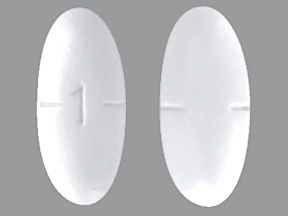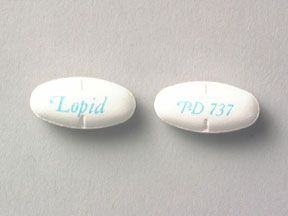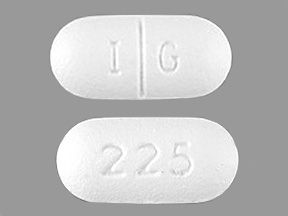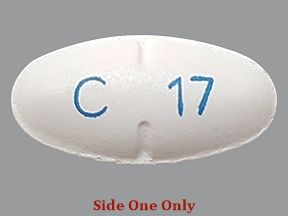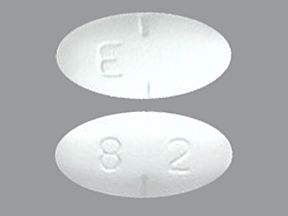Highlights for gemfibrozil
- Gemfibrozil oral tablet is available as a brand-name drug and a generic drug. Brand name: Lopid.
- Gemfibrozil comes only in the form of a tablet you take by mouth.
- Gemfibrozil is used to lower triglycerides, a type of fat in your bloodstream. Having very high levels of triglycerides raises your risk of pancreatitis (inflammation of the pancreas).
- Gallstones warning: Gemfibrozil may cause you to develop gallstones. If you develop gallstones, you should stop using this drug.
- Combination with statins warning: Gemfibrozil should not be taken with simvastatin, another cholesterol drug. Using gemfibrozil with simvastatin or other drugs in the statin class may result in serious muscle toxicity. This condition can cause kidney failure or death.
Use with selexipag warning: Gemfibrozil should not be taken with selexipag, which is used to treat pulmonary arterial hypertension (PAH). Using these drugs together can raise the amount of selexipag in your body to dangerous levels.
Gemfibrozil is a prescription drug. It comes as a tablet you take by mouth.
Gemfibrozil is available as the brand-name drug Lopid. It’s also available as a generic drug. Generic drugs usually cost less than the brand-name version. In some cases, they may not be available in every strength or form as the brand-name drug.
Why it’s used
Gemfibrozil is used to lower your levels of triglycerides, a type of fat in your blood. Very high levels of triglycerides raise your risk of pancreatitis.
How it works
Gemfibrozil belongs to a class of drugs called fibric acid derivatives. A class of drugs is a group of medications that work in a similar way. These drugs are often used to treat similar conditions.
Gemfibrozil works by changing the amount of cholesterol and other fats (lipids) in your body. Gemfibrozil lowers triglyceride levels and raises HDL cholesterol levels. (HDL is considered a good type of cholesterol.)
Gemfibrozil doesn’t cause drowsiness, but it can cause other side effects.
More common side effects
The more common side effects that can occur with use of gemfibrozil include:
- stomach upset
- stomach pain
- nausea
- vomiting
- diarrhea
- constipation
- rash
- dizziness
- headache
- changes in the way things taste
- muscle pain
If these effects are mild, they may go away within a few days or a couple of weeks. If they’re more severe or don’t go away, talk to your doctor or pharmacist.
Serious side effects
Call your doctor right away if you have serious side effects. Call 911 if your symptoms feel life-threatening or if you think you’re having a medical emergency. Serious side effects and their symptoms can include the following:
- Gallstones. Symptoms can include:
- pain in the right upper part of your abdomen (stomach area)
- nausea
- vomiting
- Rhabdomyolysis (muscle toxicity). Symptoms can include:
- pain, tenderness, or weakness in your muscles
- dark-colored urine
Disclaimer: Our goal is to provide you with the most relevant and current information. However, because drugs affect each person differently, we cannot guarantee that this information includes all possible side effects. This information is not a substitute for medical advice. Always discuss possible side effects with a healthcare provider who knows your medical history.
Gemfibrozil oral tablet can interact with other medications, vitamins, or herbs you may be taking. An interaction is when a substance changes the way a drug works. This can be harmful or prevent the drug from working well.
To help avoid interactions, your doctor should manage all of your medications carefully. Be sure to tell your doctor about all medications, vitamins, or herbs you’re taking. To find out how this drug might interact with something else you’re taking, talk to your doctor or pharmacist.
Examples of drugs that can cause interactions with gemfibrozil are listed below.
Allergy and asthma drug
Montelukast is used to treat allergies and asthma. Taking gemfibrozil with it may increase your risk of side effects. Your doctor may lower your dosage of this drug if you need to take it with gemfibrozil.
Blood-thinning drug
Warfarin is used to thin the blood. When it’s used with gemfibrozil, the effects of warfarin can be increased. This raises your risk of bleeding. Your doctor may reduce your warfarin dosage and monitor you more often when starting gemfibrozil.
Cancer drugs
Taking certain cancer drugs with gemfibrozil can increase the effects of those cancer drugs. Your doctor may decrease your dosage of these drugs if you need to take them with gemfibrozil. Examples of these drugs include:
- dabrafenib
- enzalutamide
- paclitaxel
Diarrhea drug
Loperamide is used to treat diarrhea. When used with gemfibrozil, the effects of loperamide may be increased. Your doctor may decrease your dosage of loperamide if you need to take it with gemfibrozil.
Cholesterol drugs
Certain drugs that also lower cholesterol increase certain risks if taken with gemfibrozil. Don’t use these drugs with gemfibrozil. They increase your risk of muscle toxicity or kidney failure. This may occur after three weeks of combined therapy, or it can occur after several months. Examples of these drugs include:
- atorvastatin
- fluvastatin
- lovastatin
- pitavastatin
- pravastatin
- rosuvastatin
- simvastatin
Also, certain cholesterol drugs can decrease the effects of gemfibrozil. To prevent this, you should take these medications two hours or more after taking gemfibrozil. Examples of these drugs include:
- cholestyramine
- colesevelam
- colestipol
Diabetes drugs
Using gemfibrozil with certain diabetes drugs can increase the effects of those drugs. This raises your risk of severe low blood sugar levels. Don’t use these drugs with gemfibrozil. Examples of these drugs include:
- repaglinide
Other diabetes drugs may require dosing reduction when given with gemfibrozil. These include:
- glyburide
- glimepiride
- glipizide
- nateglinide
- pioglitazone
- rosiglitazone
Gout drug
Colchicine is used to treat gout. Using gemfibrozil with this drug raises your risk of serious muscle toxicity. This condition can cause kidney failure or death. You may be at greater risk if you’re a senior (aged 65 years or older) or have kidney problems.
Hepatitis C drug
Dasabuvir is used to treat hepatitis C. Don’t use this drug with gemfibrozil.
Drug for pulmonary arterial hypertension (PAH)
Selexipag is used to treat PAH. Don’t use this drug with gemfibrozil.
Disclaimer: Our goal is to provide you with the most relevant and current information. However, because drugs interact differently in each person, we cannot guarantee that this information includes all possible interactions. This information is not a substitute for medical advice. Always speak with your healthcare provider about possible interactions with all prescription drugs, vitamins, herbs and supplements, and over-the-counter drugs that you’re taking.
This drug comes with several warnings.
Allergy warning
Gemfibrozil can cause a severe allergic reaction. Symptoms can include:
- trouble breathing
- swelling of your throat
If you develop these symptoms, call 911 or go to the nearest emergency room.
Don’t take this drug again if you’ve ever had an allergic reaction to it. Taking it again could be fatal (cause death).
Warnings for people with certain health conditions
For people with kidney problems: Gemfibrozil may make your kidney disease worse. If you have kidney failure, you should not use gemfibrozil.
For people with heart disease: Gemfibrozil has not been shown to decrease your risk of death from heart disease. Your doctor may stop your use of gemfibrozil if it doesn’t cause a large decrease in your triglycerides.
Warnings for other groups
For pregnant women: Gemfibrozil is a category C pregnancy drug. That means two things:
- Research in animals has shown adverse effects to the fetus when the mother takes the drug.
- There haven’t been enough studies done in humans to be certain how the drug might affect the fetus.
Talk to your doctor if you’re pregnant or planning to become pregnant. This drug should be used only if the potential benefit justifies the potential risk.
If you become pregnant while taking this drug, call your doctor right away.
For women who are breastfeeding: Gemfibrozil may pass into breast milk and may cause side effects in a child who is breastfed. Talk to your doctor if you breastfeed your child. You should not breastfeed and use this drug at the same time.
For seniors: The kidneys of older adults may not work as well as they used to. This can cause your body to process drugs more slowly. As a result, a higher amount of a drug stays in your body for a longer time. This increases your risk of side effects.
All possible dosages and drug forms may not be included here. Your dosage, drug form, and how often you take the drug will depend on:
- your age
- the condition being treated
- the severity of your condition
- other medical conditions you have
- how you react to the first dose
Drug forms and strengths
Generic: Gemfibrozil
- Form: oral tablet
- Strengths: 600 mg
Brand: Lopid
- Form: oral tablet
- Strengths: 600 mg
Dosage for high cholesterol
Adult dosage (ages 18–64 years):
The typical dosage is 600 mg twice per day.
Child dosage (ages 0–17 years):
It has not been confirmed that gemfibrozil is safe and effective for use in children. Do not use in children younger than 18 years.
Senior dosage (ages 65 years and older):
The kidneys of older adults may not work as well as they used to. This can cause your body to process drugs more slowly. As a result, a higher amount of a drug stays in your body for a longer time. This increases your risk of side effects.
If you have kidney problems, your doctor may start you on a lowered dosage or a different medication schedule. This can help keep levels of this drug from building up too much in your body.
Disclaimer: Our goal is to provide you with the most relevant and current information. However, because drugs affect each person differently, we cannot guarantee that this list includes all possible dosages. This information is not a substitute for medical advice. Always speak with your doctor or pharmacist about dosages that are right for you.
Gemfibrozil is used for long-term treatment. Your doctor may decide to stop gemfibrozil after three months of therapy if you don’t have enough change in your triglyceride levels.
This drug comes with serious risks if you don’t take it as prescribed.
If you stop taking the drug suddenly or don’t take it at all: Your triglyceride levels may rise. If your triglyceride levels are too high, you’re at higher risk of heart disease or pancreatitis.
If you miss doses or don’t take the drug on schedule: Your medication may not work as well or may stop working completely. For this drug to work well, a certain amount needs to be in your body at all times.
If you take too much: You could have dangerous levels of the drug in your body. Symptoms of an overdose can include:
- stomach upset
- headache
- muscle pain
If you think you’ve taken too much of this drug, call your doctor or seek guidance from the American Association of Poison Control Centers at 1-800-222-1222 or through their online tool. But if your symptoms are severe, call 911 or go to the nearest emergency room right away.
What to do if you miss a dose: Take your dose as soon as you remember. But if you remember just a few hours before your next scheduled dose, take only one dose. Never try to catch up by taking two doses at once. This could result in dangerous side effects.
How to tell if the drug is working: You should have a decrease in your triglycerides and an increase in your HDL levels. You may not feel any different when taking this medication. Your doctor will monitor your cholesterol levels to make sure the drug is working for you.
Keep these considerations in mind if your doctor prescribes gemfibrozil for you.
General
- This drug should be taken before meals. Take it 30 minutes before your morning and evening meals.
- Do not cut or crush the tablet.
Storage
- Store gemfibrozil at room temperature between 68°F and 77°F (20°C and 25°C).
- Keep this drug away from light.
- Don’t store this medication in moist or damp areas, such as bathrooms.
Refills
A prescription for this medication is refillable. You should not need a new prescription for this medication to be refilled. Your doctor will write the number of refills authorized on your prescription.
Travel
When traveling with your medication:
- Always carry your medication with you. When flying, never put it into a checked bag. Keep it in your carry-on bag.
- Don’t worry about airport X-ray machines. They can’t harm your medication.
- You may need to show airport staff the pharmacy label for your medication. Always carry the original prescription-labeled container with you.
- Don’t put this medication in your car’s glove compartment or leave it in the car. Be sure to avoid doing this when the weather is very hot or very cold.
Clinical monitoring
Your doctor will monitor your triglyceride levels while you take this drug. They may check your triglyceride levels every 3 to 12 months to make sure this drug is working.
Your diet
In addition to using gemfibrozil, a good diet is important to help you control your triglyceride levels. Weight loss can also help get triglyceride levels back into a normal range. Talk to your doctor or dietitian for more information.
There are other drugs available to treat your condition. Some may be better suited for you than others. Talk to your doctor about other drug options that may work for you.
Disclaimer: Healthline has made every effort to make certain that all information is factually correct, comprehensive, and up-to-date. However, this article should not be used as a substitute for the knowledge and expertise of a licensed healthcare professional. You should always consult your doctor or other healthcare professional before taking any medication. The drug information contained herein is subject to change and is not intended to cover all possible uses, directions, precautions, warnings, drug interactions, allergic reactions, or adverse effects. The absence of warnings or other information for a given drug does not indicate that the drug or drug combination is safe, effective, or appropriate for all patients or all specific uses.


